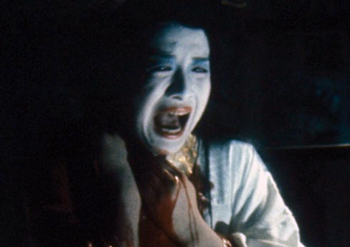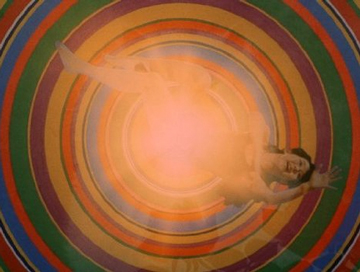
 |
|
|
|
Why is it that Japanese genre films were so often five years ahead of their Western counterparts? Nobuhiko Obyashi's 1977 horror opus House is a wholly original creation, an eclectic pop collage that resembles an exaggerated teen fantasy inspired by the jumpy aesthetic of TV commercials. Among the movie's many bizarre visual inventions is a monstrous house that disgorges enough blood to flood a neighborhood, predating and out-bleeding Stanley Kubrick's elevator from Hell in The Shining. Critics have done their best to describe House in terms of American models, invoking After School Specials, The Monkees and even Sesame Street. What we're really looking at is the Japanese equivalent of the "bubblegum" pop aesthetic found here in Teen Beat and now going strong in the commercialized insanity of "Teen Disney" TV and radio. Writer-Director Nobuhiko Obayashi's facility with consumer oriented pop visuals springs from his career as a director of TV commercials, which in the crowded Japanese media market clobber the customer with color, flash and glamour. The movie is even framed in a flat 1.33:1 TV aspect ratio. The movie begins as a giddy, mindless teen fantasy concerning a group of nubile schoolgirls, all of whom have nicknames but no real names. "Gorgeous" (Kimiko Ikegami) is upset that she won't be spending the summer alone with her Daddy (Saho Sasazawa), a widower, who plans to bring along his beautiful new girlfriend. Gorgeous joins her "function-coded" girlfriends Melody, Fantasy, Prof, Mac, Kung Fu and Sweet, who are going to a resort with Mr. Togo, a favorite teacher. When Mr. Togo's plans fall through, the girls follow Gorgeous to spend the summer at the remote house of her "Auntie" (Yoko Minimada). The fun romp in the country turns sinister when the wheelchair-bound Auntie proves to be merely a ghost projection of the house itself. Auntie lost her only love long ago in the war, and has become part of a spirit that feeds on youth. She tells the fat girl Mac that she looks tasty, and tells the rest, "You give me energy". 
An early tip-off for Japanese audiences is the emphasis given Auntie's white cat. As the director explains in the film's extras, the Japanese cinema didn't have horror films per se, but instead a "ghost and fantasy" genre in which ghost cats figure heavily. The seven schoolgirls are in the same fix as the dance students in Suspiria, except that House doesn't deliver realistic slaughter. Even the horror elements remain a fantasy as filtered through a young girl's experience. For instance, the survivors in this absurd haunted house hold out hope that a "white knight" figure will rescue them. When we last see this unlucky male, he's been transformed into a pile of bananas. With its constant barrage of pop songs, some with English lyrics, the movie maintains a jaunty, giggly attitude even in the midst of sinister events. Director Obayashi uses every technical trick in his advertising playbook to give House an appropriately agitated surface: fast wipes, irises, split screen shots, blue-screen mattes, video mattes, distorting lenses, animation, pixillation, exaggerated sets and musical bits. Several sets are backed by arresting artificial painted cycloramas, as in the horror classic Kwaidan. And that's before the supernatural content kicks in. Obayashi will accentuate an emotional moment by briefly superimposing an iris close-up of a smiling face over a wide shot. Acknowledging the teen glamour context, he frequently frames the girls in picture-perfect cute close-ups. Mr. Togo lives in an idealized, brightly colored neighborhood that looks like a set from Sesame Street. Many establishing shots involve elaborate, transparently artificial mattes, some no more realistic than Terry Gilliam's animated collages for Monty Python. When the girls giggle and sing their way through a farewell at the train station (and are sent on their way by the cute boys of the rock group Godiego), they're dwarfed by a painted cityscape suitable for a child's storybook. The train then travels through more animated storybook backgrounds. Auntie's tragic tale is presented as an aged B&W movie, complete with splices and film perforations. Her boyfriend was lost in the war, and the photographer's flash at her sister's wedding cuts directly to an atomic blast. Obayashi's 11 year-old daughter Chigumi suggested the basic concept of a house that eats girls. Ghosts are hungry for life, and Auntie was cheated of her personal happiness. A disembodied, hungry head emerges from Auntie's well. Menacing futons consume another girl, because Chigumi remembered being intimidated by futons when she was little. Although the valiant Kung Fu does her best, when the house suddenly locks its guests inside even her talents cannot break through the walls. Auntie disappears into a haunted refrigerator, and a painting of a demon cat seems to be directing the madness. A skeleton dances, a hand is eaten, and a girl is attacked by a hail of firewood. One girl is devoured by the fiendish works of a grandfather clock. As their numbers dwindle the girls rush from one floor of the house to another, like the cartoon characters in the old Scooby Doo, Where are You? TV show. Yet the film generates a strong sense of concern for its seven trapped heroines. 
When Gorgeous comes into contact with a magic mirror, the full horror of House is revealed. She is transformed into yet another manifestation of the fatal haunted bride character that forever waits for her lover. The subject at hand is the horror of the loss of innocence: an older woman denied sex consumes girls not yet initiated into adulthood. The extent of Gorgeous's sexual experience is her sensual application of red lipstick. The tidal wave of blood can be easily interpreted along the same lines. House remains an ambivalent, weird construction to the end, when its bubblegum pop aspects have vanished and the new phantom of the House greets her first visitor-victim. This Japanese ghost bride resembles the Latin American Llorona figure, who searches for her lost infant. Immensely popular in Japan, House is still remembered there as a highly original thriller. Another movie about virgins disappearing under mysterious circumstances -- with a completely different cinematic approach -- is Peter Weir's 1975 Picnic at Hanging Rock. Criterion's DVD and Blu-ray of House contain a colorful and spotless transfer of this intriguing oddity from Japan. The HD image reveals the cut 'n' paste effect strategies used to create the film's constant parade of cartoonish illusions. Viewers will no doubt rush to disc producer Curtis Tsui's special edition features for insights on this bizarre film. The long-form featurette Constructing a "House" collects director Obayashi, his daughter Chigumi and the film's screenwriter Chiho Katsura. Chigumi's scary childhood memories included getting a finger caught in the keyboard during a piano lesson. That incident inspired the film's outrageous set piece in which a killer piano bites off a girl's fingers, then her hands, and finally chews her into pieces. We learn that the director found his cast among the young models and actresses that appeared in his TV commercials. Obayashi offers interesting insights about working with a Toho film crew, as well as his reasons for purposely designing his special effects to look "fake". 1 Also impressive is Obayashi's 40-minute 1966 movie Emotion. The similarly fractured fable claims to be an account of a crew filming a commercial, but turns into an erotic exploration of experimental technique. Vampire and spaghetti western movies figure into the nonsense storyline, frequently interrupted by meaningless inter-titles. Essentially an extended visual non sequitur, the movie and its polished techniques maintain viewer interest far longer than similar avant-garde efforts. A video appreciation of Obayashi's film by director Ti West is little more than the director telling us how much House impressed him. The only aspect that Criterion's presentation doesn't cover is House's thematic maturity over the majority of European horror films being made at the time. The oppressively misogynistic fantasies of the slash 'n' slaughter Euro-horror pictures of the 1970s typically equate women with evil and employ a harsh double standard to punish any expression of sexuality. Within its giddy pop culture trappings, the ghosts of House comment directly on the role of women and the frustration of lives without love.
On a scale of Excellent, Good, Fair, and Poor,
House Blu-ray rates:
Footnote:
1. Personally, it's good to see veteran DVD producer Marc Walkow's name on the featurette and 'appreciation'; back in 1999 Walkow encouraged me to become a full-time reviewer.
Reviews on the Savant main site have additional credits information and are often updated and annotated with reader input and graphics. Also, don't forget the 2010 Savant Wish List. T'was Ever Thus.
Review Staff | About DVD Talk | Newsletter Subscribe | Join DVD Talk Forum |
| ||||||||||||||||||